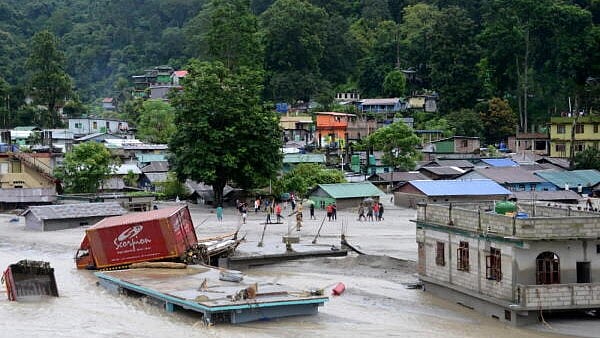
A flood affected locality at Singtam, in Gangtok district, Wednesday, Oct. 4, 2023. File Photo
PTI
Mumbai: New scientific study confirms climate change played a key role in deadly South Lhonak Glacial Lake Outburst Flood (GLOF) in Sikkim in October 2023.
The event had caused 55 fatalities, left 70 missing, and destroyed critical infrastructure, including hydropower facilities and highways.
The study, led by an international team of scientists, including the International Centre for Integrated Mountain Development’s new Cryosphere Lead Mohd Farooq Azam, reveals critical insights into the triggers, dynamics, and future risks of such climate-induced disasters in the Himalayas.
The GLOF was triggered by the collapse of 14.7 million cubic meters of frozen moraine, releasing a tsunami-like wave that devastated the Teesta Valley, the study states.
This event ranks among the most catastrophic GLOFs to hit the Himalaya in recent decades.
The research, led by a team of international scientists from nine countries, examines the triggers, dynamics, and cascading impacts of the flood, offering critical insight for Himalayan communities vulnerable to climate-induced disasters.
Using high-resolution satellite imagery and modelling techniques, the study reveals that the GLOF was triggered by a collapse of up to 14.7 million cubic meters of frozen moraine material into the South Lhonak Lake. This collapse generated a tsunami-like wave approximately 20 meters high, which eroded the lake’s frontal moraine dam, releasing about 50 million cubic meters of water – equivalent to 20,000 Olympic sized swimming pools.
“The South Lhonak GLOF serves as a grim reminder for similar high-risk lakes across the region,” said Ashim Sattar, Assistant Professor at Indian Institute of Technology-Bhubaneswar and lead author of the study. “
We urgently need a multi-faceted approach, including early warning systems, strengthened regulatory frameworks, and community education, to mitigate these risks.”
The flood severely impacted settlements and infrastructure along the Teesta River, breaching the Teesta III dam in Chunthang district. The study highlights the role of cascading hazards, where initial flooding triggered secondary landslides and debris flows, compounding the destruction
“This research paper exemplifies global collaboration among Earth scientists, using cutting-edge satellite imagery and modelling techniques to unravel the complexities of cryospheric hazards.” said Mohd. Farooq Azam, Intervention Manager, Cryosphere, ICIMOD, and a co-author of the study.
“This study reveals how climate change is amplifying glacial hazards, with the 2023 Sikkim GLOF triggering an unprecedented cascade of destruction. It underscores the urgent need for better early warning systems, resilient infrastructure, stronger regional cooperation to mitigate future risks, and, most of all, faster action to switch to renewable energy especially among high emitting economies,” said Arun Shrestha, Senior Climate Change Specialist, ICIMOD.